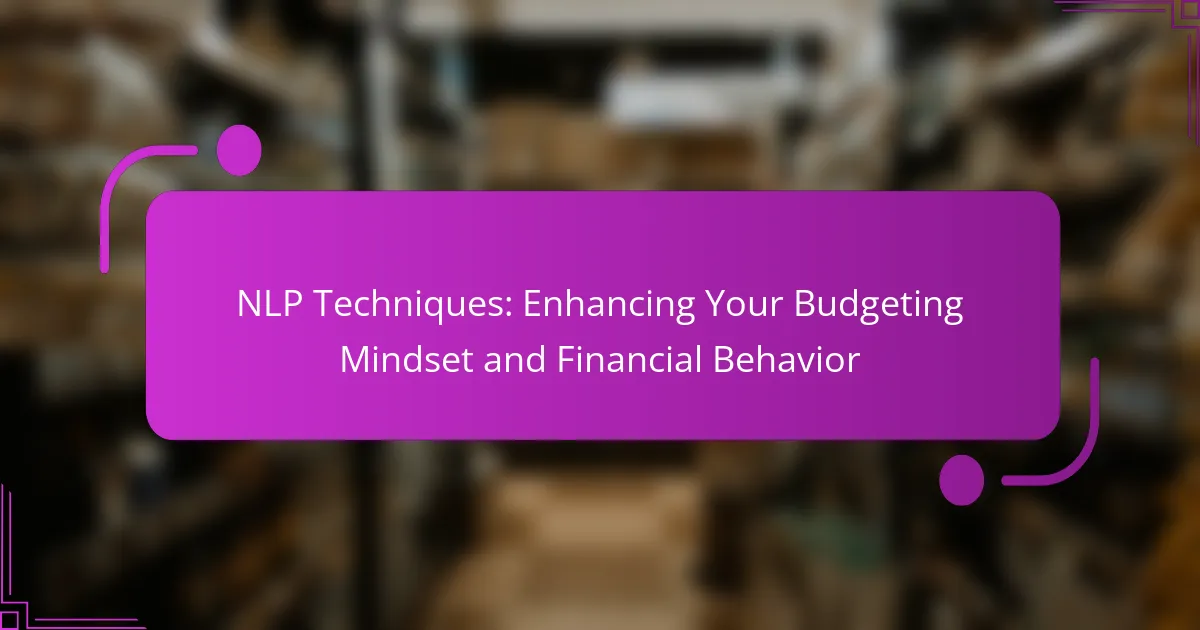Psychological barriers such as fear, ingrained habits, and cognitive overload can significantly impede effective budgeting. By recognizing these challenges, individuals can implement strategies to overcome them, leading to improved financial health and stability. Embracing flexibility and setting realistic goals are key steps in managing perfectionism and fostering a more positive budgeting experience.

What are the common psychological barriers to budgeting?
Common psychological barriers to budgeting include fears, habits, and cognitive overload that hinder effective financial planning. Understanding these barriers can help individuals develop strategies to overcome them and achieve better financial health.
Fear of financial instability
The fear of financial instability often prevents individuals from committing to a budgeting plan. This anxiety can stem from past experiences of financial hardship or uncertainty about future income. Acknowledging these fears is the first step in addressing them.
To combat this fear, consider creating a safety net by saving a small emergency fund. Aim for at least three to six months’ worth of living expenses to provide a buffer against unexpected financial challenges.
Perfectionism in financial planning
Perfectionism can lead to paralysis in budgeting, as individuals may feel that their plans must be flawless before implementation. This mindset can result in delays or avoidance of budgeting altogether. Recognizing that no budget will be perfect is essential.
Instead of striving for perfection, focus on creating a flexible budget that allows for adjustments. Start with a basic outline of income and expenses, and refine it over time as you gain more insights into your spending habits.
Overwhelm from complex financial data
Complex financial data can overwhelm individuals, making budgeting feel like a daunting task. The abundance of information, from bank statements to investment portfolios, can lead to confusion and inaction. Simplifying the data is crucial for effective budgeting.
To manage this complexity, break down your financial information into manageable sections. Use simple spreadsheets or budgeting apps that categorize expenses and income clearly, allowing for easier tracking and decision-making.
Emotional spending habits
Emotional spending habits often arise from stress, boredom, or social pressures, leading individuals to make impulsive purchases that derail their budgets. Recognizing triggers for emotional spending is vital for developing healthier financial behaviors.
To counteract emotional spending, implement a waiting period before making non-essential purchases. Consider a 24-hour rule to assess whether the purchase is necessary or simply a reaction to emotions.
Procrastination in financial decision-making
Procrastination can significantly hinder effective budgeting, as individuals may delay setting up or reviewing their budgets. This avoidance often stems from fear of confronting financial realities or feeling overwhelmed by the task at hand.
To overcome procrastination, set specific, achievable goals for your budgeting process. Schedule regular check-ins, such as monthly reviews, to keep yourself accountable and make budgeting a routine part of your financial management.

How can individuals overcome fear of financial instability?
Individuals can overcome the fear of financial instability by taking proactive steps to manage their finances effectively. This involves building a safety net, setting achievable goals, and seeking guidance from financial professionals.
Establish an emergency fund
Creating an emergency fund is a crucial step in alleviating financial anxiety. Aim to save at least three to six months’ worth of living expenses in a separate account to cover unexpected costs like medical bills or car repairs.
Start small if necessary; even a few hundred dollars can provide a sense of security. Regularly contribute to this fund, treating it as a non-negotiable expense in your budget.
Set realistic financial goals
Setting realistic financial goals helps individuals focus on achievable outcomes, reducing feelings of overwhelm. Break down larger goals into smaller, manageable steps, such as saving a specific amount each month or paying off a particular debt within a set timeframe.
Use the SMART criteria—Specific, Measurable, Achievable, Relevant, Time-bound—to ensure your goals are clear and attainable. This structured approach can foster motivation and track progress effectively.
Seek professional financial advice
Consulting with a financial advisor can provide personalized strategies to address financial fears. Professionals can help assess your financial situation, recommend budgeting techniques, and suggest investment options tailored to your risk tolerance.
Look for advisors with a fiduciary duty, meaning they are legally obligated to act in your best interest. This ensures you receive trustworthy advice that aligns with your financial goals.

What strategies can help manage perfectionism in budgeting?
To manage perfectionism in budgeting, it’s essential to embrace flexibility and focus on realistic goals. This approach helps reduce anxiety around achieving an ideal budget and encourages consistent progress instead.
Adopt a flexible budgeting approach
A flexible budgeting approach allows you to adjust your budget based on changing circumstances. Instead of rigidly sticking to a predetermined plan, consider revising your budget monthly or quarterly to reflect actual expenses and income fluctuations.
For example, if you unexpectedly receive a bonus, allocate those funds to savings or debt repayment rather than feeling pressured to spend it. This adaptability can alleviate the stress associated with perfectionism.
Focus on progress over perfection
Shifting your mindset to prioritize progress rather than perfection can significantly ease budgeting challenges. Set achievable financial goals, such as saving a certain percentage of your income each month, rather than aiming for an unrealistic budget balance.
Celebrate small victories, like sticking to your grocery budget for a month. Acknowledging these achievements can motivate you to continue improving without the burden of perfectionism.
Use budgeting tools like Mint or YNAB
Utilizing budgeting tools such as Mint or You Need a Budget (YNAB) can simplify the budgeting process and reduce the pressure to achieve perfection. These platforms offer features that help track expenses, set goals, and visualize your financial progress.
For instance, YNAB encourages users to allocate every dollar to a specific category, promoting proactive financial management. Explore these tools to find one that aligns with your budgeting style and helps you stay on track without the stress of perfectionism.

How can one simplify complex financial data?
Simplifying complex financial data involves breaking it down into manageable parts and using tools that enhance understanding. By leveraging visual aids and categorizing expenses, individuals can gain clearer insights into their financial situation.
Utilize visual budgeting tools
Visual budgeting tools, such as pie charts and graphs, can help individuals easily interpret their financial data. These tools transform numbers into visual representations, making it simpler to see where money is allocated and identify areas for improvement.
Many budgeting apps offer features like color-coded categories and trend lines, which can highlight spending patterns over time. For example, a pie chart showing monthly expenses can quickly reveal if a significant portion is going towards discretionary spending.
Break down expenses into categories
Categorizing expenses is a practical step to simplify financial data. By grouping spending into categories like housing, transportation, groceries, and entertainment, individuals can better understand their financial habits.
Consider using a simple method like the 50/30/20 rule, where 50% of income goes to needs, 30% to wants, and 20% to savings. This approach provides a clear framework for managing finances and helps in identifying areas that may require adjustments.
Engage in financial literacy programs
Participating in financial literacy programs can enhance understanding of budgeting and financial management. These programs often cover essential topics such as creating a budget, understanding credit, and managing debt.
Look for local workshops or online courses that offer practical advice and tools. Many community organizations provide free or low-cost resources, making it accessible for anyone looking to improve their financial knowledge.

What are effective methods to combat emotional spending?
To combat emotional spending, individuals can adopt strategies that promote mindfulness and self-discipline. Recognizing triggers and implementing practical budgeting techniques can significantly reduce impulsive purchases.
Identify triggers for emotional spending
Understanding what prompts emotional spending is crucial. Common triggers include stress, boredom, or social pressures. Keeping a journal to track spending habits can help identify these emotional cues.
Implement a waiting period
Before making a non-essential purchase, consider a waiting period of at least 24 hours. This pause allows time to reflect on the necessity of the item and can help curb impulsive decisions.
Create a budget and stick to it
Establishing a clear budget is essential for managing finances effectively. Allocate specific amounts for discretionary spending and prioritize essential expenses. Regularly reviewing and adjusting the budget can help maintain financial discipline.
Use cash instead of credit
Paying with cash can limit spending and make transactions feel more tangible. Consider withdrawing a set amount for discretionary spending each week to avoid overspending on credit cards.
Seek support from others
Sharing financial goals with friends or family can provide accountability and encouragement. Joining a support group focused on budgeting can also offer valuable insights and motivation to stay on track.



